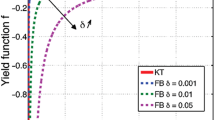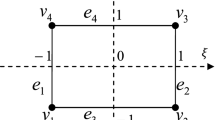Abstract
A high order finite element approach is applied to elastoplastic problems in two as well as in three dimensions. The element formulations are based on quadrilaterals and hexahedrals, taking advantage of the blending function method in order to accurately represent the geometry. A comparison of h- and p-extensions is drawn and it is shown that thin-walled structures commonly being analysed by dimensionally reduced elements may be consistently discretized by high order hexahedral elements leading to reliable and efficient computations even in case of physically nonlinear problems.
Similar content being viewed by others
REFERENCES
Düster A. (2001). High Order Finite Elements for Three-Dimensional Thin-Walled Nonlinear Continua, Ph.D. thesis, Lehrstuhl für Bauinformatik, Technische Universität München.
Düster, A., and Rank, E. (2001). The p-version of the Finite Element Method compared to an adaptive h-version for the deformation theory of plasticity. Comput. Methods Appl. Mech. Engrg. 190, 1925–1935.
Düster, A., Bröker, H., and Rank, E. (2001). The p-version of the finite element method for three-dimensional curved thin walled structures. Internat. J. Numer. Methods Engrg. 52, 673–703.
Düster, A., and Rank, E. (2002). A p-version finite element approach for two-and threedimensional problems of the J 2 flow theory with non-linear isotropic hardening. Internat. J. Numer. Methods Engrg. 53, 49–63.
Holzer, S., and Yosibash, Z. (1996). The p-version of the finite element method in incremental elasto-plastic analysis. Internat. J. Numer. Methods Engrg. 39, 1859–1878.
Simo, J. C., and Hughes, T. J. R. (1998) Computational Inelasticity, Springer-Verlag, New York.
Szabó, B., and Babuška, I. (1991). Finite Element Analysis. John Wiley and Sons, New York.
Szabó, B., Actis, R., and Holzer, S. (1995). Solution of elastic-plastic stress analysis problems by the p-version of the finite element method. In Babuška, I., Flaherty, J. et al. (eds), Modeling, Mesh Generation, and Adaptive Numerical Methods for Partial Differential Equations, IMA Volumes in Mathematics and its Applications, Vol. 75, Springer, New York, pp. 395–416.
http://www.ibnm.uni-hannover.de/Forschung/Paketantrag/Benchmarks/benchmark.html
Author information
Authors and Affiliations
Rights and permissions
About this article
Cite this article
Düster, A., Niggl, A., Nübel, V. et al. A Numerical Investigation of High-Order Finite Elements for Problems of Elastoplasticity. Journal of Scientific Computing 17, 397–404 (2002). https://doi.org/10.1023/A:1015189706770
Issue Date:
DOI: https://doi.org/10.1023/A:1015189706770




